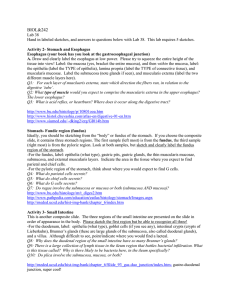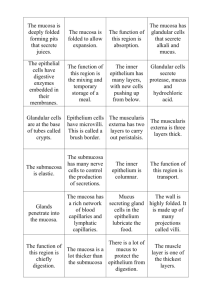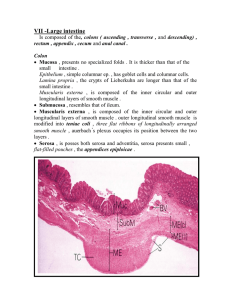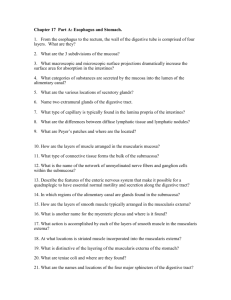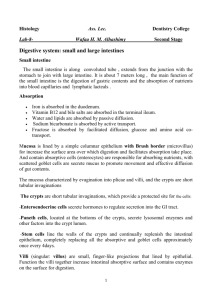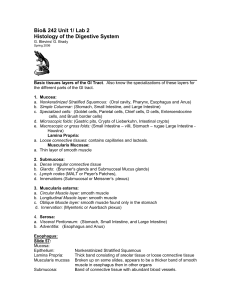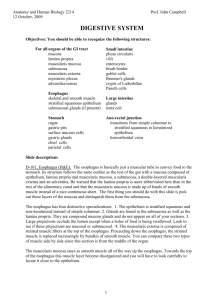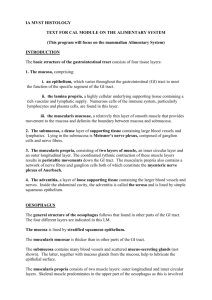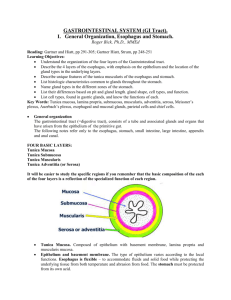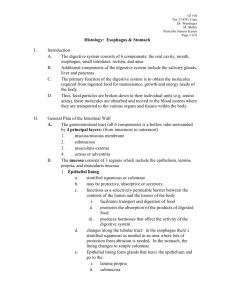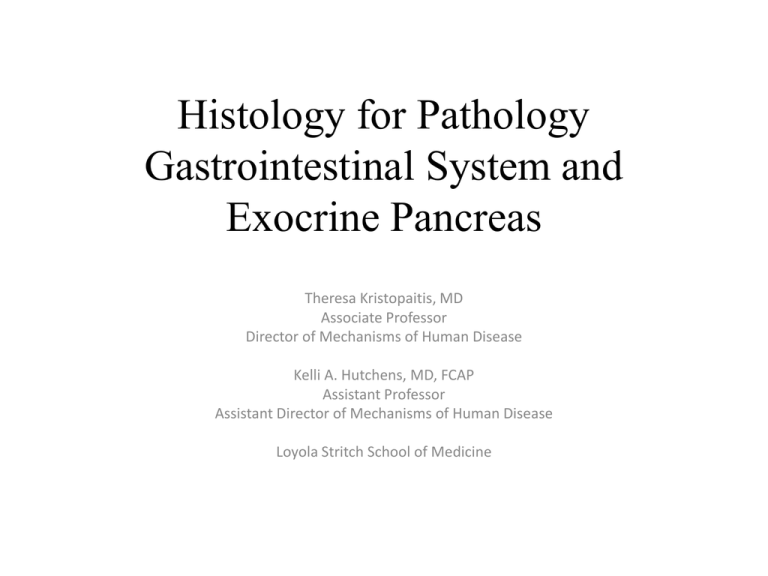
Histology for Pathology
Gastrointestinal System and
Exocrine Pancreas
Theresa Kristopaitis, MD
Associate Professor
Director of Mechanisms of Human Disease
Kelli A. Hutchens, MD, FCAP
Assistant Professor
Assistant Director of Mechanisms of Human Disease
Loyola Stritch School of Medicine
Objectives
• On H&E stained sections, identify the four general layers of the digestive tract
organs (esophagus, stomach, small bowel, colon): Mucosa; submucosa; muscularis
externa, and adventitia/serosa
• On H&E stained sections identify the following components of the mucosa:
epithelium, lamina propria, muscularis mucosa
• Describe the components of the submucosal layer of the digestive organs
• Explain the location of Meissner plexus vs Auerbach plexus and describe the
function of each
• Name the type of epithelium comprising the mucosa of the esophagus, stomach,
small bowel, appendix, colon and anal canal.
• Identify submucosal glands in the esophagus and describe their function.
• Describe the composition of the esophagogastric junction
• Name the four parts of the stomach.
• Identify gastric pits and explain their function.
• On high power H&E stained sections distinguish parietal cells from chief cells. List
the substances secreted by each of the cells.
Objectives
•
•
•
•
•
•
•
•
•
Identify the following key components of the small intestine:
Duodenum: villi, Brunner glands
Jejunum: villi, goblet cells
Ileum: villi, goblet cells, Peyer patches
Define Crypts (or Glands) of Lieberkuhn.
Contrast vili vs plicae circulares
On H&E stained sections distinguish colon from small intestine.
Define taenia coli.
In H&E stained sections of pancreas distinguish the endocrine
components of the pancreas from the exocrine components.
• In H&E stained sections of pancreas identify pancreatic acinar cells
vs ducts.
Oral Cavity
• Inner surface of the lips, cheeks, soft palate,
surface of tongue, and floor of the mouth
– Nonkeratinized stratified squamous epithelium
– Lamina propria
– Submucosa
• Gingiva and hard palate
– Keratinized stratified squamous epithelium
– Lamina propria
• Tongue: specialized mucosa with papillae
Digestive Tract
• Comprised of hallow organs
– Esophagus
– Stomach
– Small intestine
– Large intestine
• Histologic organization:
– Mucosa:
• Epithelium, lamina propria, muscularis mucosa
– Submucosa:
• connective tissue, vessels, and Meissners plexuses, some times
mucous glands
– Muscularis externa: 2-3 layers of smooth muscle (plus skeletal muscle
in esophagus), myenteric (Auerbach) plexus in between muscle layers
– Serosa and adventitia: Outermost layer of loose connective tissue and
blood vessels. Call serosa if covered my mesothelium; adventitia
otherwise
Esophagus
• Mucosa: non-keratinizing stratified squamous
• Submucosa: contains mucous glands
– Increased mucous glands at lower esophagus (GE
junction) to protect esophagus from gastric juices
• Muscularis externa: inner circular and outer
longitudinal
– Contains skeletal muscle fibers
Esophagus
Squamous
mucosa
Submucosa
Muscularis
Externa
Mucosa
Adventitia / Serosa
Muscularis
mucosa
Gastric-Esophageal Junction
(Esophagogastric junction)
Stomach
• Anatomically and histologically divided into
cardia, fundus body, and pylorus
– Cardia: first section; separate from esophagus by
cardiac sphincter. Glands contain mucus-secreting
cells, stem cells, enterendocrine, and occasional
parietal cells
– Fundus and body: largest portion. Fundic glands
contain parietal cells and chief cells with some stem
cells, mucous cells and enteroendocrine cells
– Pyloric region: lower end that connects to
duodenum; ends at pyloric sphincter. Glands primarily
mucus-secreting cells and two special endocrine cells:
gastrin-secreting (G cells) and somatostatin-secreting
cells (D-cells)
Mucosa of the Stomach
Columnar Epithelium
Gastric Pit
Fundic Mucosa
Parietal Cells :
secrete HCL
Fundic Gland
Chief Cells : secret zymogen granules
containing pepsinogen
Small Intestine
• Major site for absorption of nutrients and its mucosa is
made for this!
– Villi and microvilli
– Glands (crypts) of Lieberkuhn in lamina propria that open into
the mucosa at the base of villi.
• Paneth cells with pink granules at the base of the crypts secrete
lysozymes, tumor necrosis factor-alpha, and defensins.
– Submucosa with Meissner plexus
• Three sections
– Duodenum: Brunner glands (mucus secreting)
– Jejunum: long villi and increased goblet cells – no Brunner
glands or Peyer patches
– Ileum: Short villi, many goblet cells, and lymphatic nodules in
the submucosa called Peyer patches
Duodenum
Mucosa
Brunner’s Glands
Paneth Cells
Jejunum
Goblet
Cells
Ileum
Paneth
Cells
Peyers patches
Small Intestine: Paneth Cells
Small Intestine
Large Intestine
• Major site of absorption of water and salts
• Mucosa: No villi, gland of Lieberkuhn with many goblet cells and no
paneth cells.
• Submucosa: no glands
• Muscularis externa: Inner circular muscle plus outer longitudinal
muscle with myenteric (Auerbach) plexus between.
– Outer longitudinal muscle creates three narrow bands called tenia coli.
• Four anatomic sections
–
–
–
–
Cecum :
Appendix
Colon
Rectum and anal canal
Large Intestine Mucosa
Goblet
Cells
Colon Wall
Mucosa
Submucosa
Muscularis externa
(circular portion)
Muscularis Externa
Appendix
Lymphatic
Nodules
Anal -Rectal Junction
Exocrine Pancreas
• Many serous secretory cells (pancreatic acinar
cells) form acinar structures.
– Cytoplasm contains zymogen granules
• Secretions carried by main duct to join bile
duct at the ampulla in the duodenum
Main pancreatic duct and surrounding acini
Main Duct
Pancreatic Acini

